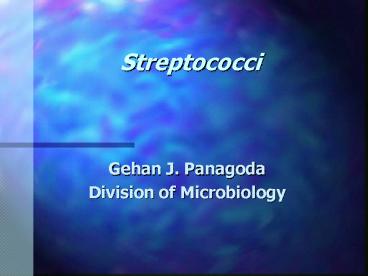Streptococci - PowerPoint PPT Presentation
1 / 32
Title: Streptococci
1
Streptococci
- Gehan J. Panagoda
- Division of Microbiology
2
Morphology
- Gram ve, chains, diplo, initially from
erysipelas, divisions one plane, mention about
Staph, length of chains varies on culture
conditions. No relationship between length and
virulence
3
? haemolysis
Strep and pus
Cervical lymph adenitis
Tonsilitis
4
Culture
- Aerobes, facultatively anerobic, pathgenic Strep
require exacting nutrients. Therefore, grow well
in BA. 10 CO2 promotes growth and haemolysis.
5
- Haemolysis Alpha, partial with greenish
discolouration (unidentified reductant
haemoglobin - viridans strep and pneumococcus
(NO SUCH THING CALLED STREP. VIRIDANS). Beta, a
wide clear zone, beta haemolysins - Streptolysin
O and S - S. pyogenes. Gamma - non-haemolytic
(commonly used term) - S. faecalis.
6
Classification
- For aerobic and facultative anaerobic
- .Haemolytic classification
- I have already mentioned about this. Most of the
pathogenic Strep causing primary infections fall
into beta. Alpha Strep is generally remains as
commensals.
7
- .Serological classification - For beta haemolytic
Strep - 1. Based on the group specific polysaccharide (c)
antigen of the cell wall - Lancefield
classification, 20 A-V, No I and J. THE MOST
IMPORTANT GROUP IS A - S. pyogenes.
8
- 1.1 Based on the type specific antigen (M, T, R
most important is A - Mass Transit Railway) - for
S. pyogenes serotyping - Grifith classification -
80 serotypes. M is on the cell, resists
phagocytosis, promotes adherence to the host.
WITHOUT M IS AVIRULENT.
9
- .Classification based on Schleifer and
Kilpper-Balz (1987) -Based on the structure of
the cell wall and G C composition (NOT
IMPORTANT FOR YOU).
10
S. pyogenes
- PATHOGENIC FEATURES -
- 1. M that is the type specific antigen
- 2. Capsular hyaluronic acid - capsule also in gp
C during the logrithmic phase. ANTIBODIES
PRODUCED AGAINST THE CAPSULE IS NOT PROTECTICE.
11
- MEANS THE CAPSULE IS A VIRULENT FACTOR, SIMILAR
TO THAT OF PNEUMOCOCCUS, INHIBITS PHAGOCYTOSIS
12
- 3. Toxins and enzymes
- Toxins - Streptolysin S and O - have already
mentioned. Streptolysin O acts not only against
red cells but also cytotoxic to neutrophils and
platelets and cardiac tissue. An ASO titre of
160-200 units - suggests a recent infection.
Erythrogenic toxin - the rash of scarlet fever.
13
- Enzymes
- Streptokinase - lyse RBC, prevents a fibrin
barrier around the leision thus spread - Nicotinamide adenine dinucleotidase (NADase)
14
- Hyaluronidase - acts on hyaluronic acid -
antibodies against this is diagnostic. THEREFORE,
ASO AND THIS IS IMPORTANT IN DIAGNOSIS OF S.
PYOGENES INFECTIONS
15
.Suppurative infections
- Acute infections of the respiratory tract. Sore
throat-(acute tosillitis/and or pharyngitis -
organisms are at the site - can spread and cause
cervical adenitis, otitis media, meningitis.
Scarlet fever- a complication of sore throat,
rash is due to erythrogenic toxin, organism is
not at the site.
16
- Skin infections - Impetigo - among children,
discrete infections, highly communicable, common
in countries like Sri lanka (Why ? hot and
humid). Organism is at the site. Can cause also
by Staph. aureus Erysipelas mainly among elderly
- acutely spreading infection. Some time is
associated with sore throat. Organism is present
at the site. Believed to be a hypersensitivity
reaction.
17
Erysipelas - Butterfly-wing rash
- Followed by upper
- respiratory tract infection
- On the face or leg
- Transferred by fingers
18
Scarlet fever
Caused by an erythrogenuc strain Portal of
entry is the throat May followed by infection of
wound/burn
19
(No Transcript)
20
- Pathogenesis
- (Immune mechanism) Ab produced against protein
and polysaccharide of orga cross react with
myocardial and heart valve tissue Not clear. - Immune response Marked ASO titre ? 200 Moderate
to low - Course Progressive Spontaneous resolution
- Penicillin
- Prophylaxis Because of repeated attacks,
Penicillin - Prophylaxis is Essential Not indicative
21
- .Laboratory diagnosis
- .Acute suppurative infections
- Smear - Strep and pus Culture - in a transport
medium, on BA 370C , ? haemolysis, overnight,
better under anaerobic with 5-10 CO2, ELISA to
detect Strep antigens, Serological tests - not
useful
22
- .Non-suppurative complication
- Culture - useful for the presence of Strep/
serological test to check the level of ASO titre
? 200 for rheumatic fever, DNAase-B test for
acute nephritis
23
(No Transcript)
24
(No Transcript)
25
- .Other haemolytic Streptococci
- Group B -S. agalactiae - bovine mastitis,
neonatal septicaemia and meningitis - Group C and G
- ENTEROCOCCI - Group D
- STREPTOCOCCUS MILLERI (UK term) in USA (S.
intermedius) (Group F) alpha, beta of gamma,
present in the mouth, throat GI tract, infect
internal organs, brain liver,
26
(No Transcript)
27
Suacute bacterial endocarditis
- Splinter haemorrhages
- Lodging of emboli under finger nails
- other than kidneys and brain
28
(No Transcript)
29
(No Transcript)
30
(No Transcript)
31
(No Transcript)
32
(No Transcript)































